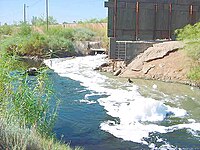
Photo from wikipedia
Emerging contaminants (ECs) have become an increasing area of concern due to the likely impacts of these compounds on human health and the environment. Generally, products which are used for… Click to show full abstract
Emerging contaminants (ECs) have become an increasing area of concern due to the likely impacts of these compounds on human health and the environment. Generally, products which are used for households and personal care activities contribute to major percentage of ECs in household greywater. Not much information on the presence of xenobiotic organic compounds in greywater is currently available. Therefore, the present study focused on the qualitative and quantitative analyses of emerging contaminants from different classifications of Indian households. The qualitative screening of emerging pollutants by solid-phase extraction–gas chromatography and mass spectroscopy (SPE-GC-MS) showed the presence of 78 different emerging contaminants from three different sources, which are categorized into ten different groups based on their chemical properties. The quantitative analysis of few selected target pollutants such as phthalic esters, namely diethyl hexyl phthalate, diethyl phthalate, dibutyl phthalate, dioctyl phthalate, triclosan, bisphenol A, caffeine, acetaminophen, 3-methyl salicylic acid, 4-octylphenol, and 4-nonylphenol were found to be 0.38 ± 0.39 μg/L, 1.57 ± 1.54 μg/L, 4.77 ± 2.57 μg/L, 0.712 ± 0.17 μg/L, 5.82 ± 1.85 μg/L, 11.08 ± 2.64 μg/L, 2.30 ± 1.19 μg/L 13.18 ± 4.48 μg/L, 3.75 ± 1.90 μg/L, 4.95 ± 2.21 μg/L, and 5.96 μg/L, respectively. Risk assessment indicated that 63 compounds identified in the greywater can be considered priority pollutants. Based on the results obtained in the present study, effective zero-discharge liquid system can be designed for different sources of greywater and it can be recycled and reused without much risk. Graphical abstract .
Journal Title: Environmental Monitoring and Assessment
Year Published: 2020
Link to full text (if available)
Share on Social Media: Sign Up to like & get
recommendations!